The West Midlands Metro system is, right now, in the midst of a major expansion, and it is not letting the coronavirus pandemic stand in its way. In fact, in a subtle way, the virus has brought some small, but surprising, economic and social benefits to the construction process.
The West Midlands Metro has been in operation for just over twenty years now, first opening for passengers in May 1999. The route from Wolverhampton, running south-east to ‘central’ Birmingham for 13 miles and broadly following the corridor of the national rail route from Wolverhampton to Birmingham Snow Hill, saw the return of trams to Birmingham for the first time since their removal in 1953.
Initially, ridership was not as high as envisaged at the outset of the scheme proposals. In part, this may have been due to the service terminating at Snow Hill station, which, whilst being convenient for some offices, businesses and shops, is not regarded locally as exactly ‘central’ to the city. Slightly less significant, in terms of motivation of usage, was the fact that the Wolverhampton terminus, St. George’s, whilst in the shopping quarter, was not adjacent to the national rail station.
The first of these situations has already been addressed. The Birmingham ‘city centre’ terminus was extended to Grand Central, adjacent to New Street station, with intermediate stops at St. Chad’s, Bull Street and Corporation Street, bringing the tram service further into the city centre. This extension came into use in May 2016 and annual usage jumped from around 5.0 million passenger journeys per year, first to over 6.0 million and eventually to 8.0 million.
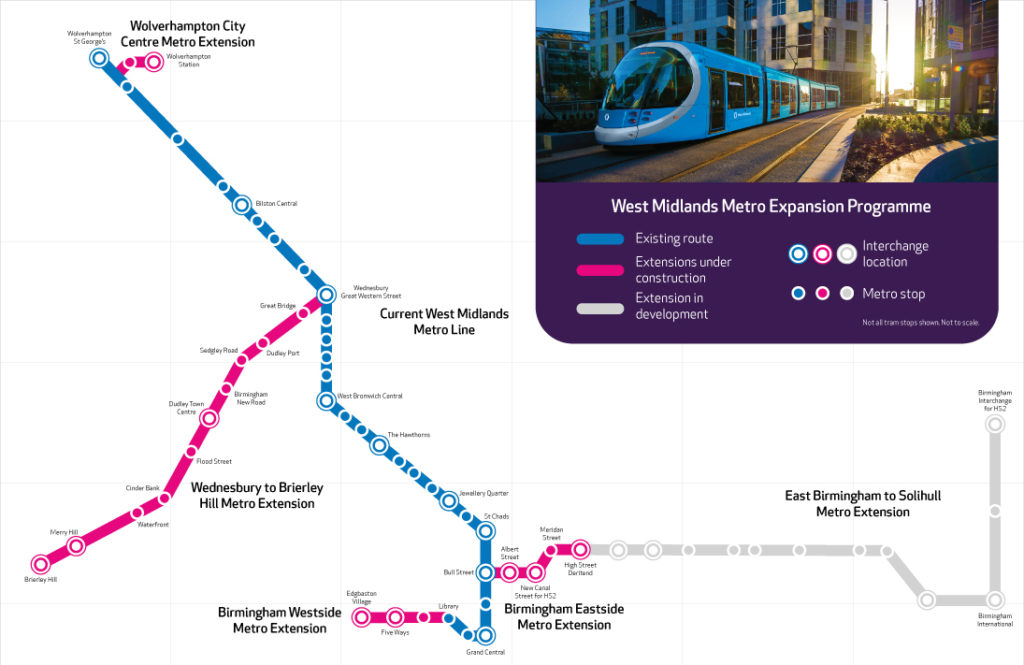
At the Wolverhampton end of the route, extending the tram to the main railway station is one of four significant extensions to the Metro which are currently underway:
- Birmingham Westside Metro extension
- Wolverhampton City Centre Metro extension
- Birmingham Eastside Metro extension
- Wednesbury to Brierley Hill Metro extension
Also currently under development and evaluation is the East Birmingham to Solihull Metro extension, which will extend to Birmingham Airport and HS2’s Interchange station, but this proposal is longer term.
Transport Authority and Project Management
Funding, ownership, management and operation of the Metro has evolved once or twice since its original creation. Since 2016, these arrangements have stabilised under the authority of Transport for West Midlands (TfWM), which established the Midland Metro Alliance (MMA) to plan, design and build extensions to the West Midlands Metro on its behalf. The MMA consists of the West Midlands Combined Authority, which owns the Metro, a consortium of design experts from Egis, Tony Gee and Pell Frischmann, and rail construction specialists Colas Rail. In turn, Colas Rail has recruited sub-alliance partners Colas Ltd., Barhale, Bouygues UK and Auctus Management Group to carry out specialist services within the overall construction partnership.
Michael Anderson, director of projects for West Midlands Metro, emphasised to Rail Engineer that a major benefit of the alliance has been the creation of relationships whereby it is easier to develop and build extensions and enhancements to the network without resort to a new form of contract each time. The contractors understand that there is always the possibility of future work under established business conditions and arrangements whilst, at the same time, the client is not under obligation to guarantee any specific volume of work.
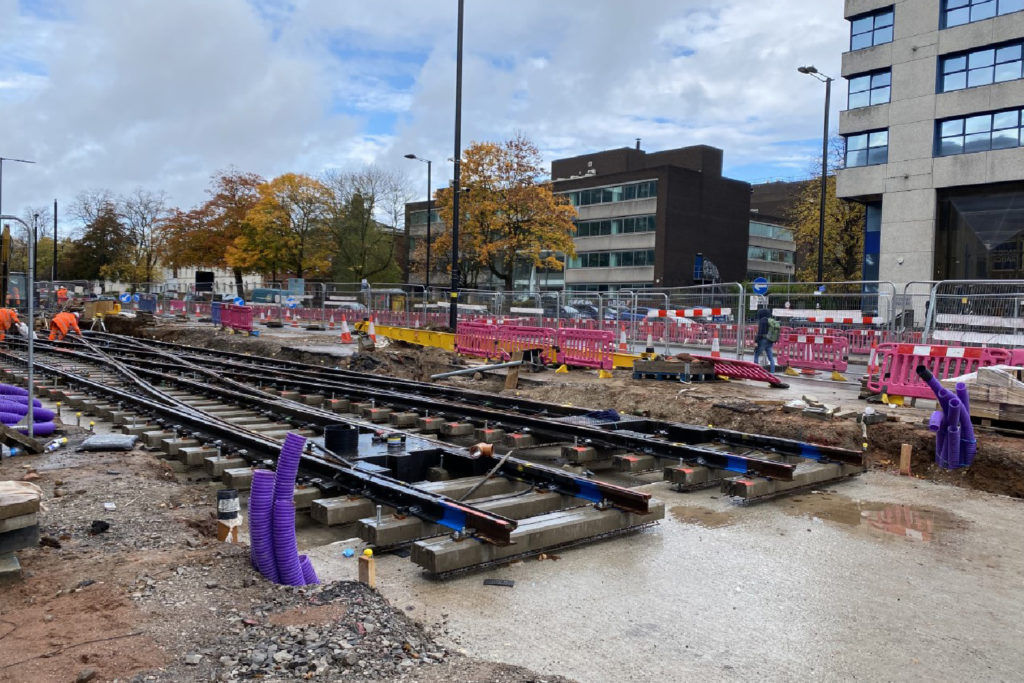
Current extensions in progress
Birmingham’s western extension continues the original Line 1 from Grand Central up through Victoria and Centenary Squares, along Broad Street, through the Five Ways underpass to a new Edgbaston terminus on Hagley Road. The first section of this extension, as far as Centenary Square, was opened early in December 2019, giving easy access to the Birmingham Museum and Art Gallery, the International Convention Centre and Symphony Hall. The remainder of the extension will be open by the end of this year.
The underpass at Five Ways was closed to road traffic in June 2019 and track laying there and throughout Broad Street is largely complete. Later this year, there will be 12 weeks of testing and commissioning, followed by shadow running in readiness for opening in December 2021.
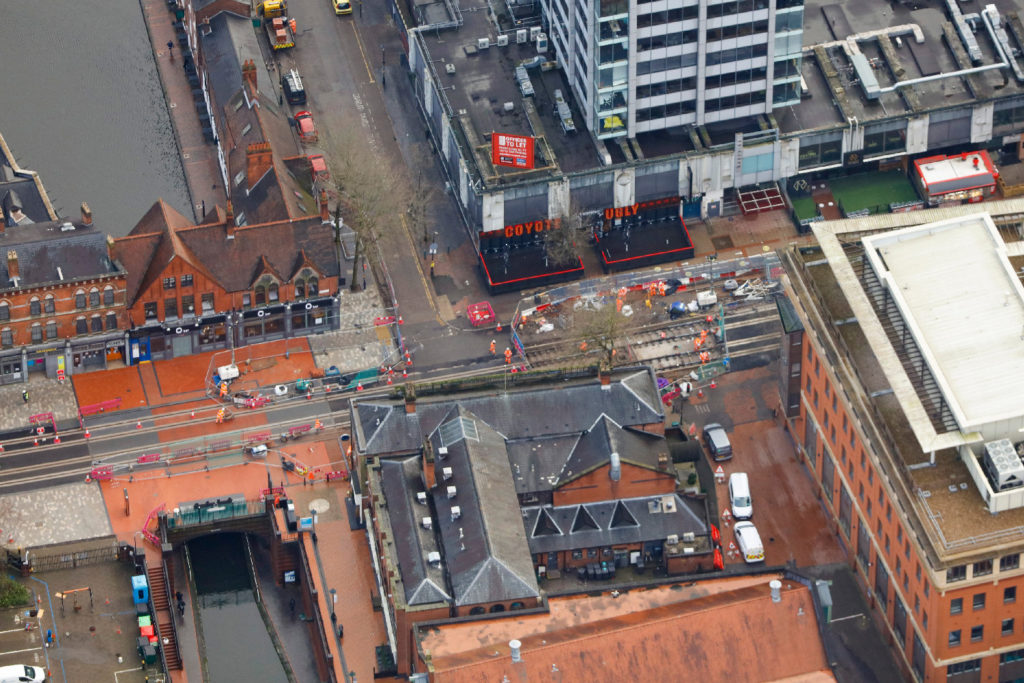
Of particular note, this extension is the first tram system in the country that is using battery power. For aesthetic reasons, the use of catenary wires through the heritage areas of Victoria and Centenary Squares was deemed unsuitable. Also, for structural clearance through Five Ways underpass, catenary was a problem. Therefore, the CAF Urbos 3 trams, which are part of the West Midlands Metro fleet, use the manufacturer’s available modification to use lithium-ion supercapacitors and batteries to run through these sections.
The second extension currently under construction – Wolverhampton City Centre Metro extension – is a short spur from the original route that is being built to provide an additional terminus at the main rail station, which is currently being redeveloped. This spur will open in autumn 2021. Trams arriving from the south will alternate between St. George’s tram stop and Wolverhampton station as their destination. With the opening of this line, a major transport hub of train, bus and tram will be created for the Black Country city.
The extension to the east of Birmingham city centre will consist of a branch from Line 1 at Bull Street, continuing past Moor Street station, the new HS2 terminal and Curzon Street terminating at High Street Deritend. Early work, such as diversion of utility services, has already commenced. The target is to open this branch in 2025/6, which should tie in with the projected start of HS2 services.
The major enhancement of the overall Metro network, in terms of extent, will be the Wednesbury to Brierley Hill Metro extension, on which significant physical work has recently commenced. The first section of the route, between Wednesbury and Dudley, makes use of a portion of the closed South Staffordshire Railway. This route is projected to help regenerate the Dudley and Sandwell areas.
Dudley, in particular, will be able to capitalise on the route for a number of other projects, including the Very Light Rail Centre and the Dudley Institute of Technology. The route will also improve connectivity by standardising journey times and link Dudley with both Birmingham and Wolverhampton by tram. The route should be open sometime in 2024.
Employment and training opportunities
MMA has a mission to employ staff as locally as possible, to support people getting back into work and to encourage young people to consider a career in construction and railway engineering. They were in the lead, with other employers from the UK’s Light Rail industry, in designing and founding a level two apprenticeship scheme for individuals wanting to develop a career in the tramway construction environment. In November 2020, this Trailblazer Apprenticeship in Light Rail won the Institution of Civil Engineers Education and Inspiration Award.
MMA also supports local colleges in the provision of sector based training in appropriate disciplines. Along with other companies and authorities this proves to be a mutually beneficial arrangement. By funding a percentage of the course costs, MMA partner companies have an entitlement to participate in the pre-selection of course candidates and also to evaluate them after completion. Whether a particular individual eventually ends up working for MMA or not is not regarded as a major drawback as both the individual and the industry will have ultimately benefited.
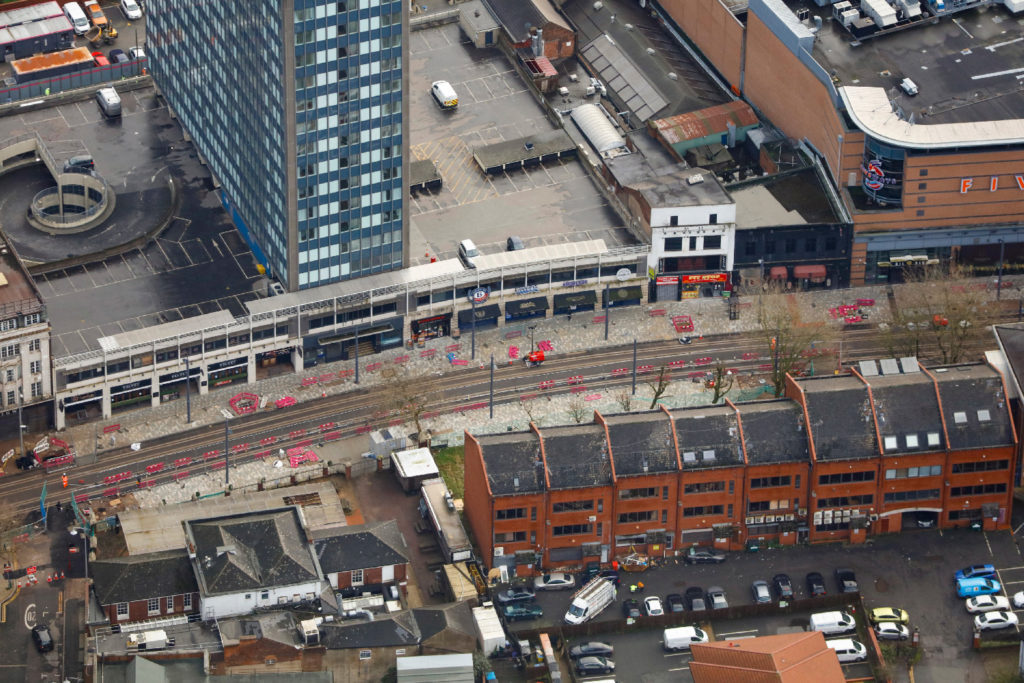
Interaction with local communities and workplace culture
MMA is committed to strong involvement with local communities throughout the region in which it operates. This shows itself in several ways, including by aiming to employ a high percentage of its workforce locally, by targeting ethnic and gender diversity, by actively encouraging young people to consider a career in construction and by providing apprenticeship and other training schemes.
One recent initiative has been the launching of Connecting Futures within MMA’s overall website. This aims to inspire young people to consider a career in construction and railway engineering by providing information, advice and guidance. Browsing this platform gives the opportunity to hear from current MMA employees about how they became involved and their career experience. There are several short videos of employees describing their specific job roles and giving focus to such topics as apprenticeships, graduate schemes and how to progress within the sector.
Prior to the onset of COVID-19, MMA’s Engagement and Skills team had shared this type of information with visits to schools, colleges and youth organisations across the West Midlands. The pandemic, and its associated restrictions, put a stop to this direct involvement and prompted the creation of the alternative on-line facility, which has broadened the accessibility of this information.
The site workforce stands currently at around 100. As work expands on the Brierley Hill route, it is anticipated that there will be between 250 and 300 staff deployed. MMA aims for a target of 90 per cent of their employees to be from the local community, as far as practical regarding the skills required.
Another example of MMA’s community approach has been the donation, to the Severn Valley Railway for reuse on their heritage line, of over a mile of track lifted from the former railway line now being developed for the Wednesbury to Brierley Hill extension.
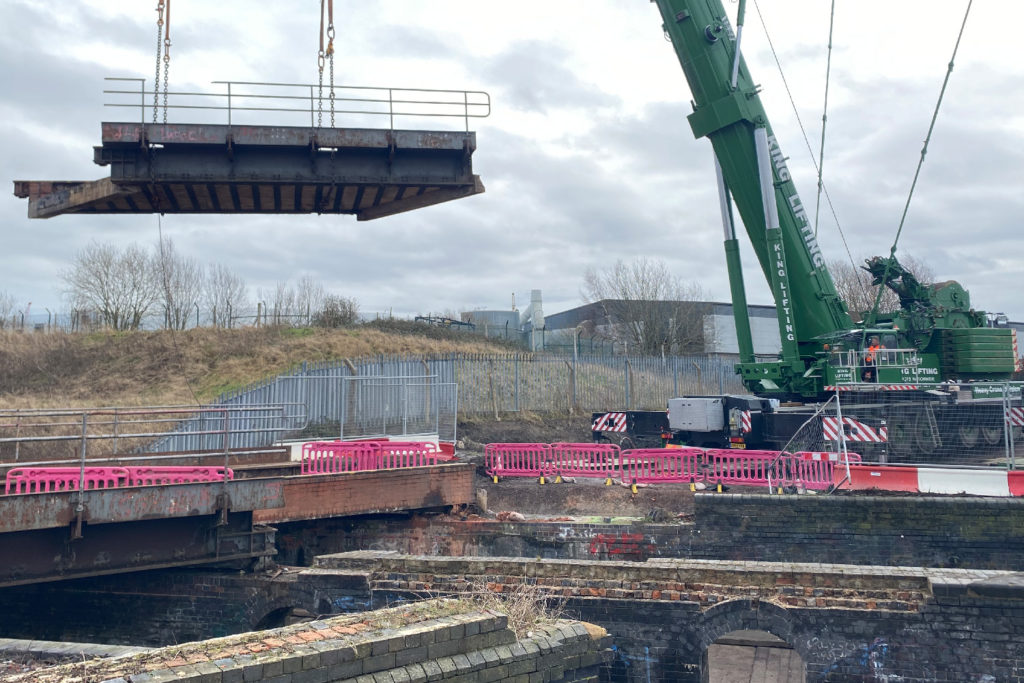
Coronavirus implications and actions
Without doubt, the COVID-19 pandemic has had its effects on the office and site activities for MMA. Not all of these have been detrimental, however.
The main office, at Alpha Tower, normally accommodates 140 staff. During the severe lockdowns, when as many staff as possible have been enabled and encouraged to work from home, only 20 have been working in the office, which has made it easier to comply with social distancing rules.
For site work, to avoid any significant disruption to construction, additional cabins and additional PPE have been provided. Also, to further assist with social distancing, a system of staggered meal breaks has been introduced. Regular testing of the workforce, by means of the lateral flow test, which gives a quick result, every five days (one-fifth of the workforce tested every day) before the start of shift has been an additional precaution. So far, only two positive tests have resulted, with individuals immediately sent home to self-isolate in line with government guidance.
Peter Cushing, director for Midland Metro Alliance, told Rail Engineer that, throughout the pandemic, he has tried to ensure that all staff feel in regular contact. This has been achieved by him sending a weekly email bulletin and every fortnight holding a live video team meeting for all. There is also an ongoing focus on positivity and well-being, concentrating on potential mental health issues throughout the organisation. Social interaction is strengthened with regular quizzes as another method of countering any feelings of isolation. There have been staff surveys looking for positive feedback and suggestions on the working environment and also canvassing views on aspects of the enforced ‘coronavirus culture’ that could be beneficial to retain long-term even after the virus.
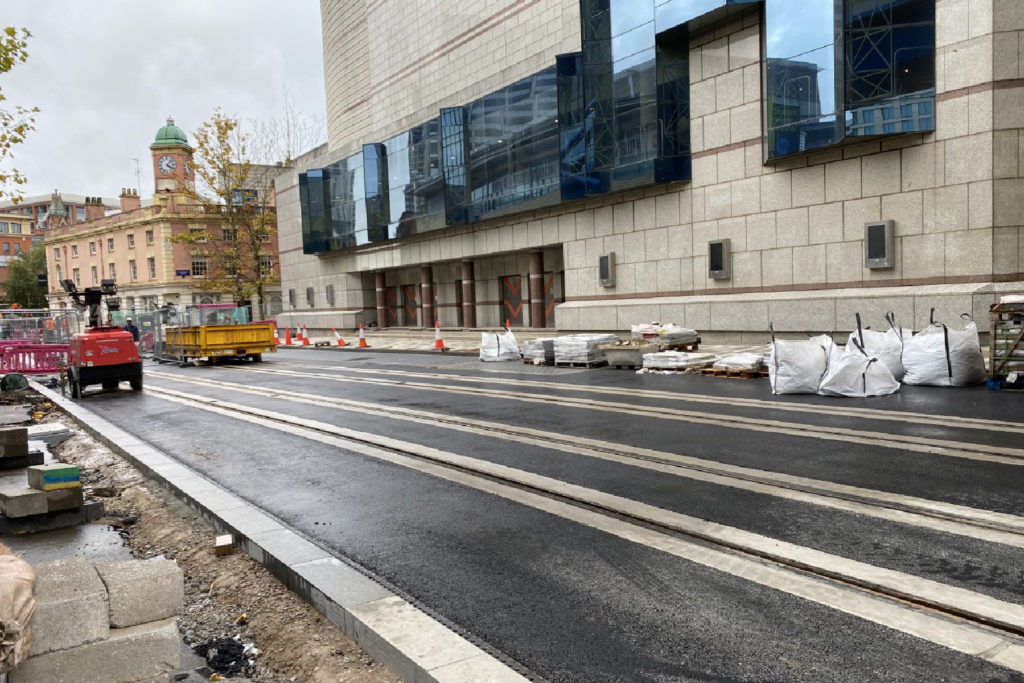
One unusual and interesting by-product of the pandemic is noteworthy. For construction of the new tracks along Broad Street from Centenary Square through to Five Ways, consideration had to be given to minimising disruption to the many bars and restaurants along with heavy vehicular and pedestrian traffic along this section of the route. Under normal circumstances, this work would be planned as a series of short sections, protected behind hoardings, with several ‘linking-ups’ to be carried out subsequently.
However, with so many premises closed by lockdown regulations, the opportunity was taken to arrange for longer sections of hoarded-off site at any one time. This has multiple benefits; greater working space for delivery and removal of materials, longer continuous casting of concrete track infill, fewer ‘linking-ups’ and an overall shorter cumulative time period of closures affecting Broad Street.
As for the operational route of the Metro, the first lockdown in Spring 2020 caused a reduction in ridership of between 70 and 80 per cent and the latest lockdown has seen a reduction of around 40 per cent.
Budgets
Noticeably, the budgets for the various network extensions are not proportionate to their geographic route lengths and there are good reasons for this.
The Westside extension, 2.15km in length, has a budget of £150 million, but this includes for the capital cost of four new tramsets;
Wolverhampton City Centre Metro extension is 0.7km, with a budget of £35 million.
Eastside extension to Deritend, only 1.7km in length, is up at £227 million. This includes the cost of expensive land acquisition through the central city section and Digbeth, more new rolling stock and complex terminal details, in conjunction with the HS2 terminus at Curzon Street;
The Wednesbury to Brierley Hill extension, 11.1km long, is budgeted at £450m. This has to fund reconstruction and/or refurbishment of some large structures and the purchase of more rolling stock.
So, the relative mix of land acquisition, infrastructure extent, new or refurbished track and structures and the capital cost of rolling stock are different in each case.
In total, a further 21 new tramsets will be purchased over the next two to three years. As a result, the depot at Wednesbury must be doubled in size and the power supply over the original line is to be upgraded.

